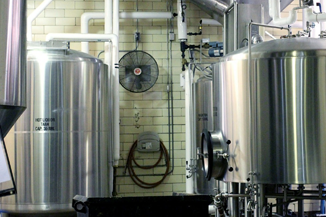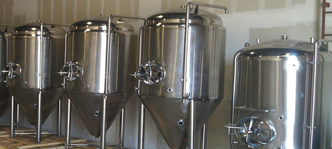Passivation of Stainless Steel Brewery, Winery, and Distillery Tanks
So you’re a craft brewer, home brewer, distillery, or winery, and you know that it is important to “passivate” your tanks and equipment. Quality is important to you, and so is doing it the right way. But what is the right way to passivate stainless steel?
 A common misconception in the brewing industry is that passivation can be done with any acid. Many brewers have an oxalic acid, phosphoric acid, and/or abrasive based cleaner handy and think that it can be also used to passivate their stainless steel. While these cleaners do help bring the stainless steel surface down to bare metal, they do not selectively remove iron, and so the metal surface created will still have a very high percentage of iron. The chromium on the surface will passivate into chromium oxide, but without a correct acid treatment, that chromium only covers at most 20% of the surface. Passivation standards like ASTM A967 do not recognize these acids for the purpose of passivating stainless steel.
A common misconception in the brewing industry is that passivation can be done with any acid. Many brewers have an oxalic acid, phosphoric acid, and/or abrasive based cleaner handy and think that it can be also used to passivate their stainless steel. While these cleaners do help bring the stainless steel surface down to bare metal, they do not selectively remove iron, and so the metal surface created will still have a very high percentage of iron. The chromium on the surface will passivate into chromium oxide, but without a correct acid treatment, that chromium only covers at most 20% of the surface. Passivation standards like ASTM A967 do not recognize these acids for the purpose of passivating stainless steel.
So how does one passivate their stainless steel tanks, then? Well, traditionally passivation was always done with nitric acid, but that stuff is not very safe to work with. Luckily there is an easier, safer and more effective way! Citric acid passivation is by far the best way for a craft or home brewer to passivate their stainless steel tanks. Citric acid is not as harsh as nitric, so it removes iron from the stainless steel surface while leaving behind the chromium and other “good stuff”. This results in the creation of an optimal passive layer that protects the stainless steel from corrosion. In fact, it also prevents contamination of the beer or wine by iron, which can ruin the taste. Citric acid passivation was originally developed by Coors Brewing back in the 1980s for this very reason.
 There are two citric acid based CitriSurf products which are ideal for passivating brewery equipment. One is CitriSurf 3050, a concentrate product which can be diluted with water and used to fill tanks or flow through a sprayball for clean in place (CIP) methods. The other is CitriSurf 2210 which is a ready to use gel which can be applied to the surface of tanks and pipes via sprayer or a brush. These products are both very safe, easy to use, and readily available.
There are two citric acid based CitriSurf products which are ideal for passivating brewery equipment. One is CitriSurf 3050, a concentrate product which can be diluted with water and used to fill tanks or flow through a sprayball for clean in place (CIP) methods. The other is CitriSurf 2210 which is a ready to use gel which can be applied to the surface of tanks and pipes via sprayer or a brush. These products are both very safe, easy to use, and readily available.
Questions? Don’t hesitate to reach out. Happy Brewing!

